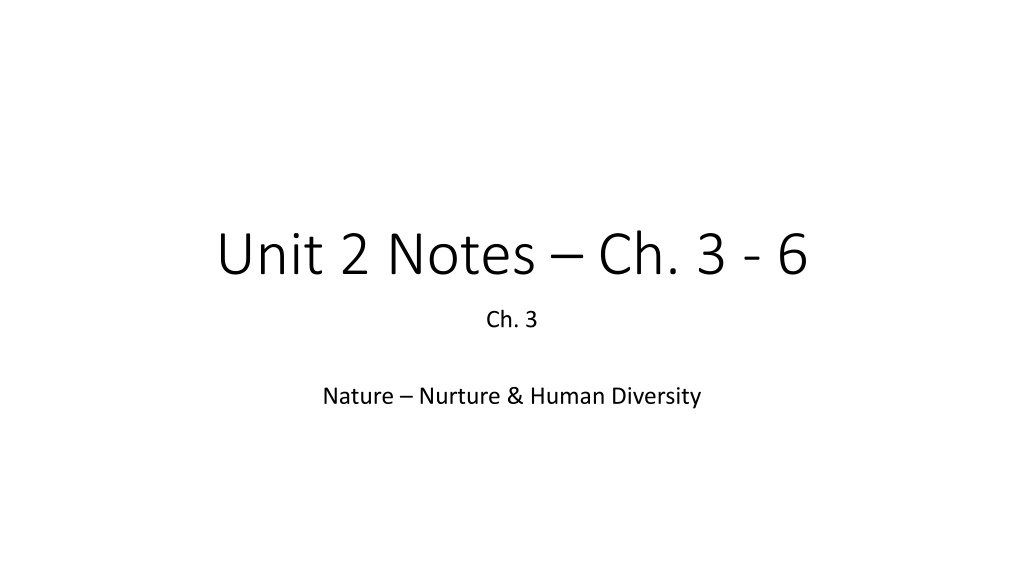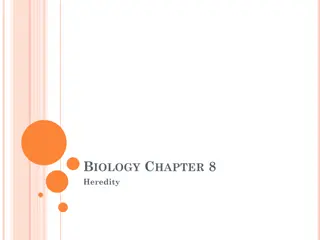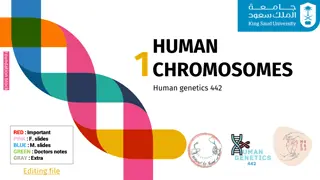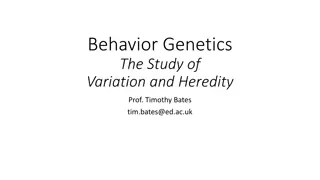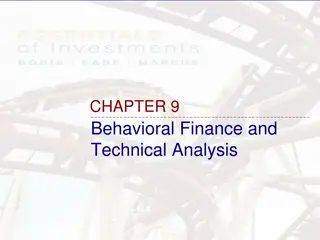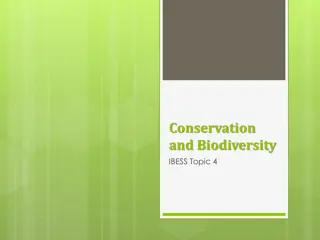Understanding Human Diversity and Behavioral Genetics
Exploring the intricate relationship between nature (genetics) and nurture (environment) in shaping human diversity. Discussing topics such as behavior genetics, twin studies, molecular genetics, evolutionary psychology, sexuality roles, influences of parents and peers, and the impact of culture and societal norms on individual identity and self-concept.
Download Presentation

Please find below an Image/Link to download the presentation.
The content on the website is provided AS IS for your information and personal use only. It may not be sold, licensed, or shared on other websites without obtaining consent from the author. Download presentation by click this link. If you encounter any issues during the download, it is possible that the publisher has removed the file from their server.
E N D
Presentation Transcript
Unit 2 Notes Ch. 3 - 6 Ch. 3 Nature Nurture & Human Diversity
Ch. 3 - Behavior Genetics: Individual Differences Chromosomes 23 Pairs XXY Klinefelter Syndrome XYY Increased Height Chromosomes contain DNA which contain Genes
Identical vs. Fraternal Twins Identical Twins: Created from the same egg; always the same sex Fraternal Twins: Created from different eggs; may be same or different sex Adoption Studies help us understand that people who grow up together do not usually resemble each other when one is adopted, suggesting that adopted children resemble their adoptive parents
Nature Nurture Contd Temperament = emotional reactivity Heritability = the extent to which variation among individuals can be attributed to their differing genes Molecular Genetics: The quest to identify which genes influence behavior
Evolutionary Psychology Darwin Survival of the Fittest aka Natural Selection Mutations Random errors in gene replication Punet Square Dominant v. Recessive genes
Sexuality Role The way one behaves Identity What one believes they are Gender Identity Disorder An individual who believes they are in the wrong body; Transgender (Transsexual) An individual who changes sexes Transvestite Cross Dressing
Parents v. Peers Parents have more influence over long term decisions Peers have more influence over short term decisions Culture behaviors, attitudes, ideas & values shared by a group of people and transmitted from one generation to the next Norms rules for accepted behavior Personal Space the buffer zone around our bodies
Culture & The Self Individualism: Giving priority to the self over the group Collectivism: Giving priority to the group over the self Social Learning Theory: Children learn roles by observing others and being rewarded or punished Gender Schema Theory: Combines SLT with cognition and cultural norms
Ch. 4 - Development Developmental Psychologists: Study physical, cognitive, & social changes throughout the life cycle Zygotes become embryos which become fetus Teratogens: Chemicals that can be dangerous to the unborn child Fetal Alcohol Syndrome: Abnormalities caused by excessive drinking
Newborns & Baby Development Rooting Reflex: After touching a baby s cheek, the baby searches for the nipple Maturation: Biological growth uninfluenced by experience Schema: A concept or framework that organizes information (a way of thinking about something).
Piaget Cognitive Development Sensorimotor Preoperational Concrete Operational Formal Operational
Sensorimotor Object Permanence: The awareness that an object exists even when not perceived (one year) Stranger Anxiety (separation anxiety): related to object permanence; the increase of anxiety when the primary parental figure leaves
Preoperational Stage Symbolic Representation: Using words to represent objects Egocentrism: The inability to understand that another may disagree with you or perceive something different than another Theory of Mind: The ability to read others mental states Assimilation: Interpreting new information in terms of an existing schema Accommodation: Changing one s schema to understand new information
Concrete Operational Stage Centration (conservation): the ability to understand 3 dimensionality Reversibility: The ability to understand positive & negative
Formal Operational Stage Abstract Thinking Ability: The ability to think hypothetically and abstractly
Freudian Theory Oral Anal Phallic Latent Genital
Freudian Theory Libido Focus of the body where sexual energy is located Fixation: Baby or child does not receive enough satisfaction within the stage; leads to later life problems
Oral Stage Focus is on the mouth Babies focus on sucking & biting Fixation results in passive dependence
Anal Stage Expulsive: Toddler uses bathrooms all over and takes great pleasure in doing so. Leads to sloppiness and disorganization Retentive: Toddler cannot use any bathroom but own. Holds as long as possible. Can lead to being OCD and overly orderly. Resolved by proper toilet training
Phallic Stage Oedipus Complex Electra Complex
Oedipus Complex The child (ages 4-6) has a subconscious sexual desire for the mother Stage is resolved by identifying with the father Fixation results in conflict with the father figure
Electra Complex The little girl is jealous of the boy because he has a penis which represents power. The girl feels inferior Resolution: Normal understanding of the difference of the genders Fixation: Becoming a male hater. Difficulty with intimacy
Womb Envy The theory was refuted: It s men who envy women because they can reproduce, creating in men a jealousy and inferiority complex.
Latent Stage Children repress their sexual feelings into the background. It manifests itself into aggressive competition.
Genital Stage The age & stage in which individuals become capable of mature sexuality and reproduction.
Erikson Social Development 8 stages of development Trust v. Mistrust Identity v. Role Confusion (Self-Esteem) Intimacy v. Isolation Integrity v. Despair
Social Development Contd Attachment Bond between a parent & infant Critical Period Ages 6 months to 3 years in which bonding must take place or serious adult disorders can occur Imprinting The following of ducks to the first creature they saw (Lorenz) Self-Concept A sense of one s own identity
Moral Development - Kohlberg Preconventional (5-10) Based on rewards & punishments Conventional (11 15) Based on laws & peer pressure Postconventional (16 - ) Based on abstract moral principles & benefits to society
Physical Development Puberty The time when one is maturing sexually Males: First ejaculation Females: First menstrual period (menarche) Primary sex characteristics: reproductive organs Secondary sex characteristics: non-reproductive traits
Emerging Adulthood Adolescence is being stretched from both ends over the past 100 years Menopause: Ending of the menstrual cycle; a woman s final period Alzheimer s: The world s most feared disease. Will hit 3% of the world s population by age 75.
Kubler-Ross Stages of Dying Denial Anger Bargaining Depression Hope
Aging & Intelligence Crystallized: Knowledge and verbal skills Fluid: Reason speedily and use hands Fluid decreases with age. Social Clock: The age at which people should get married, move out, etc Low intelligence can affect these ages.
Ch. 5 - Sensation Sensation An awareness of the senses Bottom-up processing: Starts at the senses and works its way to the brain Top-down processing: Higher level mental processes
Thresholds Absolute Threshold: Minimum stimulation necessary to notice 50% of the time Signal Detection Theory: Predicts when we will detect weak signals (hits to false alarms) Subliminal: Below the threshold Difference Threshold (JND): Minimum difference a person can detect between two stimuli, half the time Weber s Law: One must notice differences proportionally for them to be equally noticeable
Sensory Adaptation Adaptation: Diminishing sensitivity to an unchanging stimulus (we basically get used to something)
Transduction Transduction: Process by which sensory systems encode stimulus energy as neural messages (Eye-Light, Ear-Sound, Touch-pain, pressure, hot, cold, Smell & Taste- sweet, sour, salty, bitter
The Eye Light Path: Cornea, Pupil, Iris, Lens, Retina Hue-Color Retina-Rods (light & dark) & Cones (color) surrounding the fovea Accommodation-The lens changes shape to focus on near or far objects (turns inward) Nearsighted-Can t see far Farsighted-Can t see near Optic Nerve-Carries information to the brain Blind Spot-Optic nerve leaves the eye
Visual Processing Feature Detection-nerve cells that respond to specific features such as shape, angle or movement Parallel Processing-The ability to perceive several things at one time such as form, depth & movement
Color Vision Trichromatic Theory-The retina has three types of color receptors: red, green, blue Opponent Process Theory Color is processed in terms of opposing colors: black-white, red-green, blue-yellow Color blindness is nine times more common in males
Hearing Pitch: Long waves have low pitch, short waves have high pitch Decibels: Measuring units for sound energy Cilia: Dies when decibels are too intense Cochlea: The inner ear, responsible for inner deafness Conduction Hearing Loss Partial Sensorineural Hearing Loss - Total
Touch 4 Senses: Hot, Cold, Pain, Pressure Cold + Warm = Hot Pain: Gate Control Theory
Taste & Smell Controlled by the Olfactory Nerve Sweet, Sour, Salty, Bitter
Movement Vestibular Sense (Kinesthesis) Monitors Body position & movement
Ch. 6 - Perception Selective Attention: Our awareness focuses Inattentional Blindness: Failing to see visible objects when focusing our attention elsewhere Change Blindness: Failing to see an obvious change in stimuli Illusion: A misrepresentation of reality
Perceptual Organization Visual Capture: Vision dominates the senses Gestalt: An organized whole Figure Ground: The figure stands out from the background and can be reversible Grouping: Organizing stimuli into coherent groups
Methods of Grouping (AP only) Proximity: Nearby figures together Similarity: Items that are similar to each other Continuity: Smooth & continuous patterns Connectedness: Perceiving as single units
Depth Perception Depth Perception: The ability to see 3 dimensionality Visual Cliff (Eleanor Gibson): Both humans and animals perceive depth and would not crawl on to a glass covered object simulating a cliff
Retinal Disparity The separation of the eyes creates a different view of the world (binocular cue)
Monocular Cues (AP only) Relative Size: Closer objects appear larger in size Interposition: If one objects partially blocks another, we perceive it as closer Relative Clarity: We perceive hazy objects as farther away than sharp, clear objects Texture Gradient: Closer to us appears coarser rather than finer Relative Height: Objects higher in our field of vision appear farther Relative Motion (motion Parallax): stable objects appear to move as we move Linear Perspective: Parallel lines appear to converge in the distance
Motion Perception Phi Phenomenon: When two adjacent lights blink, we perceive them as a single light moving back and forth Perceptual Constancy: Perceiving objects as unchanging
